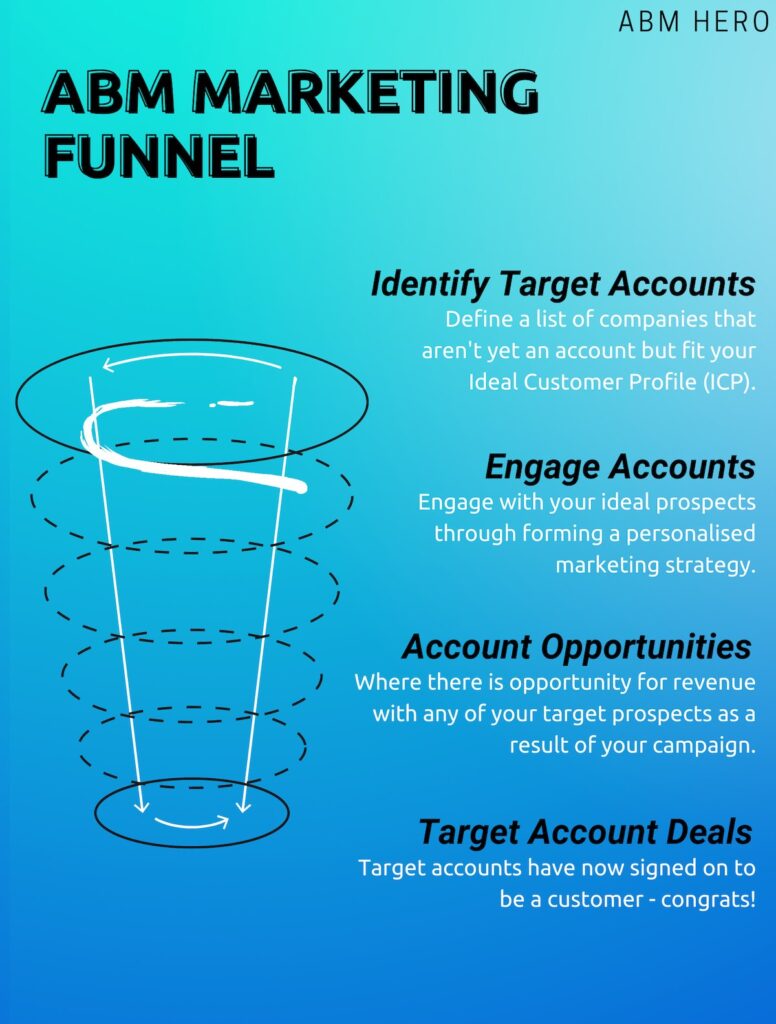What is ABX?
By now, you’ve all heard about ABM but ABX?
Account-based experience (ABX) is a marketing, sales and service strategy that focuses on one-to-one interactions with customers and prospects across the entire B2B lifecycle. The goal of this account-based approach is to provide a personal and tailored experience for each individual customer to achieve customer satisfaction.

Technically yes, but ABX combines the engaging nature of inbound marketing with the precision and targeting of account-based marketing – marrying the two funnels together to form the best of both in fulfilling the promise of account-based marketing overall.
Parallel to Account-Based Marketing (ABM) the key focus is on building long-term relationships with these individual customers rather than a one size fits all approach. Placing hyper-focus on them by ensuring all interaction points throughout and beyond initial interest such as landing target account deals and cross/up-selling opportunities during account renewal cycles, is seamless.
Customer satisfaction does more than just build a positive representation for your brand, it can help maximise ROI through creating a loop of continued satisfaction and repeated business – since customers are more likely to continue business with you if they have had a positive experience.
So How Does ABX Compare to ABM?

Well I’m sure you’re all familiar with the children’s TV classic Spongebob Squarepants… so let me put it this way. How does the Krusty Krab compare to the Chum bucket?
Bad jokes aside… consider ABX as a catalyst, like the secret ingredient that ultimately helps you generate more revenue from your ABM campaign more efficiently by focusing on the customer journey.
Data building and account targeting in ABM helps you quickly identify the ideal customer for your business. Whilst intent data can inform you of whether your service can resolve your potential prospects pain points for example – the point of contact remains on your terms. There is little consideration for whether the customer wanted to be pursued in the first place.
Or say your prospect becomes a customer, and your sales success teams are pushing a proposition that is of no value to the customer – you create a breeding ground for poor customer service. ABX ‘resolves’ this by allowing the buying process to happen on their terms.
“Businesses that invest in creating great experiences grow revenue 40% faster, improve retention by 70%, and increase customer lifetime value 1.6x more than other companies” – combined with the benefits of ABM, ABX could prove to be even more beneficial for your business.
ABX has a high focus on intent data however with an ABX approach it may be used to identify what companies may be interested in your service 6-12 months from now. The priority stays on ‘ready’ prospects whilst looking out for the accounts that may not be ready right now.
Intent data used in this way can reveal opportunities and risks that have the potential to deepen customer relations. Thus, utilising data and intelligence software to reach out to customers in a relevant and respectful manner. This opens up opportunity for customer expansion whilst practising customer retention. With this in mind an ABX marketing funnel would look something like the one below.
In order to improve your marketing effectiveness with ABX, more than before you need to ensure your data is reliable as the approach incorporates the principles of data-driven engagement across every account touchpoint. This means that the sources you use for building CDPs (Customer Data Profiles), CRMs and ICPs (Ideal Customer Profiles) must use up-to-date systems that you can trust.

Customer satisfaction must be at the centre of the entire B2B lifecycle. As with ABM this requires unification of sales and marketing teams however with ABX it doesn’t end there. To achieve account-based success, all revenue teams including sales development and customer success teams must be involved. This leaves specific emphasis on how the whole organisation interacts with the customer.
Whenever you put the customer experience at the centre of your campaign, beginning to end, you’re practicing ABX.
Key Components of ABX
If you’re sold on the essential value of integrating an ABX strategy with your ABM program, there are some key components that should be part of your hybrid ABM mix:
– Personalized customer experiences
– Role-based and user-generated content
– Delivery of only the most relevant data to prospects
– Targeting potential customer within their network
– Leveraging existing data and tool with ABX efforts
It is important to ensure that you are delivering personalised campaigning throughout the entire buying process. This is the key to customer satisfaction. Don’t forget 79% of consumers say they are only likely to engage with an offer if it has been personalised to reflect previous interactions the consumer has had with the brand.
How to Optimise your ABX Campaigns for Increased ROI
Optimising ABX campaigns is not as hard as it sounds as long as there are a few basic rules to follow.
Some of the most important things to consider when optimising ABX campaigns are the following:
– Quality content that resonates with the audience
– Optimised keywords and meta descriptions for each ad
– Building backlinks in order to get higher rankings online
– Creating a steady stream of traffic through social media ads for example
ABX testing can be a great way to determine which campaign is generating the most conversions but in order for ABX optimisation to work, you need to have a clear idea of what your goals are, what your desired results are as well as what data you’re collecting.
Here are 3 ways that marketers can optimise their ABX campaigns for increased ROI:
1) Target users using different creative methods – this will help you determine which layout/approach is the best fit for your target audience.
2) Test different landing pages with the same creative output – this will help you see if there are any landing pages that your target audience responds better to, and thus, what type of message you should relay in your advertisements.
3) Use both “long-form” and “short-form” advertising – one way to optimize your ABX campaigns for increased ROI is by testing long form vs short form advertising from the beginning.
Effective B2B marketing needs a solid strategy
Whether you stick with account-based marketing or decide to try out account-based experience, for your B2B marketing to be effective you need to have a solid strategy in place. ABX sounds more complex than it is, simply put it is ABM practices achieved through alignment of marketing, sales and customer success/service teams to build customer journeys focused on individual accounts.
Think ABX may be for you? Let us know what you think of this new approach in the comments or join the conversation and become an ABM Hero via our Facebook or LinkedIn groups.
 acc
acc





